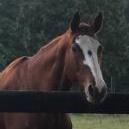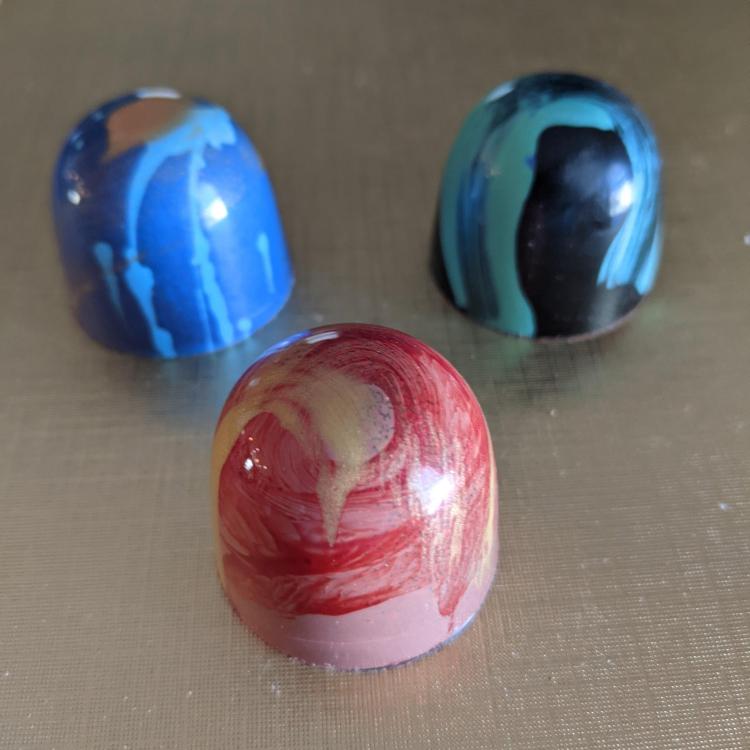-
Posts
2,263 -
Joined
-
Last visited
Contact Methods
-
Website URL
www.santiagochocolates.com
Profile Information
-
Location
Staunton, Virginia
Recent Profile Visitors
9,547 profile views
-
Thanks for the details. I am in awe of the amount of work you did for this design--and of how beautifully it turned out. I'm afraid my customers will not see an egg anywhere near this level of artistry.
-
@Saltychoc, a beautiful collection of chocolates. I especially admire the decoration of the blue and gold eggs. Do you mind telling how you got this effect?
-
Here are a couple of recipes that might be of interest: https://lucysfriendlyfoods.com/2020/12/19/pomegranate-and-grenadine-pate-de-fruits/ https://www.julescooking.com/single-post/how-to-make-pate-de-fruit-best-candy-ever Neither recipe is exactly a "professional" Boiron-style recipe, but they are interesting because they don't use any other fruit.
-
@Saltychoc I bought the Opalys from International Gourmet Foods. They have locations in various parts of the U.S., and the northern Virginia one is fairly close to me. This means the chocolate is delivered by truck, which is a good thingy primarily because I don't have to worry about melting during the warmer months. Shipping is "free," but of course I'm paying at some point. The refrigerated truck also means that I can order frozen fruit purées, but I don't know whether they have the same 12-tub minimum that AUI has (I buy my Felchlin from AUI, and again, shipping is "free"). Prices are lower at the wholesale division of Chocosphere (the only place I have found 3kg bags of Valrhona for less than $100), but shipping chocolate from Oregon to Virginia is another issue--and I just learned that Chocosphere has new owners, so who knows what that will mean?. Pastry Depot in Atlanta has just gone all wholesale, but their prices are higher than Chocosphere's.
-
I think she is very good in her teaching style, but the method of cooling seems incredibly fussy and time-consuming. I too use a cold water bath, and if I am impatient, add some ice to the water.
-
My rep at AUI said to expect a big jump in the near future for Felchlin (we didn't discuss other brands, so I don't know about that). I've also ordered what is for me a huge amount of Valrhona Opalys.
-
Yes, I have continued with experimentation. I am reasonably sure the heated warming tray was the cause of the missing colored cocoa butter. I was able to replicate the problem with heat; it did not occur without heat. If the tray's thermostat were more reliable, I think this would be the perfect solution, but it's not. So I returned to wiping the freshly sprayed molds upside down on shop towels, and the difficulty of removing the CCB returned. I followed Kerry's information on not adding too much silk and started going through the annoying procedure of weighing the CCB, using a chart to add 1% silk. Alas, the issue continued. I find it puzzling to watch countless videos of people turning their sprayed molds upside down and effortlessly wiping off the CCB. But it's one mold, and they are usually employing an airbrush not a spray gun. Next attempt: It occurred to me that even a tiny amount of silk may be contributing to overtempering and thus CCB crystallizing almost immediately. So I started using the ancient tempering method of melting the CCB, lowering its temperature to 27C, then raising it to 28-30C. I didn't have a lot of molds left in the current batch to give this idea a real test, but it seemed to give better results. With reputable chocolatiers not tempering their CCB (see above in this thread), I also was less careful when using the heat gun between molds, and that also seemed to help. Since a huge majority of chocolatiers do temper their CCB, I am not yet ready to abandon the practice. As @RanaMN pointed out, a Fuji blows a lot more CCB through the gun and creates unique issues. If I recall correctly @Chocolot uses a scraper on her molds after she has finished spraying them. Scraping makes a huge mess and sometimes removes chips of color below the tops of cavities.
-
I used pastrygirl's recipe to make a batch of homemade Orelys (and I want to thank her for doing all the work to develop a recipe). I used the same India Tree dark muscovado, but also used white sugar (as the recipe she gave me called for). After much searching I found whole milk powder (from King Arthur Flour), so I omitted the butter. I had never made any sort of chocolate in the melanger, so was not sure what to expect. It was very easy. I put the melted cocoa butter in the melanger, then added the sugar, followed immediately by the milk powder (about 1/4 cup at a time). The mixture thickened up with the powder, so I used a hair dryer for a little while until everything flowed smoothly. I had the melanger in a room where I could easily regular the temp, so I managed to get everything quite warm. Premier melangers has a recipe that is somewhat similar and calls for 3.5 hours of grinding. I found my "Orelys" was smooth enough before 3 hours. The taste is close to Valrhona's product, but it could use a little more of the muscovado taste, so next time I would use more muscovado and less white sugar (or maybe use some brown). I think it is the muscovado that gives Orelys its slightly licorice taste, and I would like to have more of that. I kept some actual Orelys for future taste comparisons. In the recipes where I used Orelys (pecan gianduja, cinnamon bun ganache), the chocolate doesn't have to stand on its own, so I am content with something close to Valrhona's product. My calculated price was about $60 for 2.5kg (compared to Valrhona's $87 price for the same amount). Would I do it again? Maybe, but given my uses of Orelys, I might be tempted to use Valrhona's Dulcey plus a little molasses powder. Washing that melanger is not as much fun as one might imagine.
-
Chef Kalle Jungstedt's own mold, which is a somewhat flattened dome, helps prevent the dome's suction effect. Chocolate World has a similar one but larger. When I am making something with several layers, those molds tend not to be large enough. The hemisphere shares the issue you mentioned with all the shallow molds I have--the one often called a quenelle and also egg shapes. They are a test of one's ability to keep a steady hand when moving the mold--and not tapping the mold too enthusiastically. They also have another irritating characteristic: some chocolate often gets between the shell (with any color it has) and the mold when sealing the mold is taking place. I did learn (I forget where) that a little heating of the mold with a heatgun before sealing the cavities helps prevent that. I think this melts the top edge enough so that the fluid chocolate can't get behind it. Ah, what we go through for beauty.
-
3 examples of the "dreaded dome"--you know, the mold that looks wonderful in theory, is easy to decorate--and loves to stick to the mold before reluctantly dropping out. @Kerry Beal once said she thought the dome fit so well in its mold that a sort of suction formed. Whatever it is, it's a pain. Fillings are (clockwise from top left: "cookies & cream," sesame crunch, cherry & almond ganache.
-

Spraying Chocolate: Equipment, Materials, and Techniques
Jim D. replied to a topic in Pastry & Baking
I think the heated sprayer is the renamed HotCHOC by renamed company Krea Swiss. I investigated that, but it is not intended for cocoa butter, just chocolate (mostly for the flocked look). I should have known that you would have come across the invention I wrote about. The more I thought about it, however, the more I questioned how it would work in the fast-moving process of spraying CCB. The wires would have to be quite long to allow for all the maneuvering required to get good coverage of a mold, not to mention the process of changing colors. I think it would be necessary to make the device easily removable. But if it can be done with the hotCHOC, it should be doable with a CCB sprayer. The market is probably not large enough to entice a company like Fuji (and its competitors) to look into it. -

Spraying Chocolate: Equipment, Materials, and Techniques
Jim D. replied to a topic in Pastry & Baking
I saw an interesting post from Tom Sampson on the "Bonbon and chocolate painting techniques" Facebook forum about a device he invented to keep an airbrush warm. Another member of that forum responded that he too is working on such a heater, and the two of them are now corresponding. Such a device might revolutionize the decorating of bonbons. -
I have the 0.8mm (recommended by Kerry and others); Fuji has them up to 2.0.
-
Not sure what you mean by "how big is the Fuji?" Are you referring to physical dimensions or volume of the spray cup? And I'm not trying to convince you. People have different priorities. The Sagola looks very much like the Fuji.
-
It's a regular Chef Rubber color (one I don't like and could easily use for experimentation). The bonbons are fully covered; it must be the light that makes them look otherwise. The Fuji does spray more than an airbrush, but it is much faster. It's a tradeoff, one I am willing to make, esp. at times like Christmas. As for wiping off overspray, just about every chocolate-spraying video I have watched includes that. If I let it fully crystallize on top of the mold, I have a terrible time cleaning it off later.











